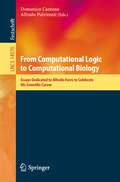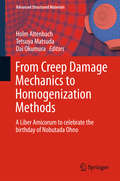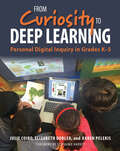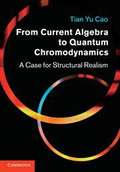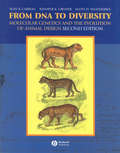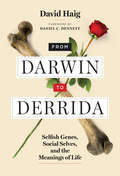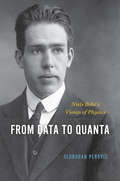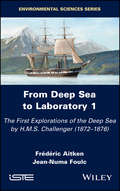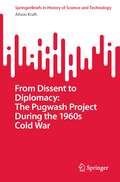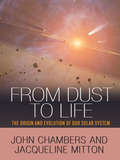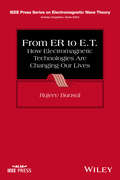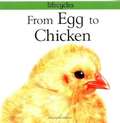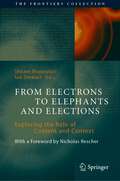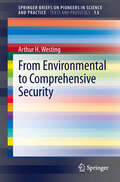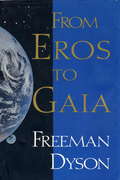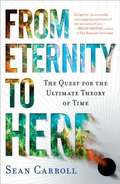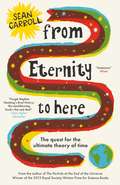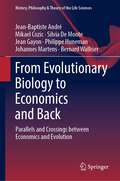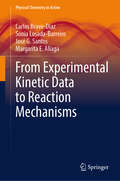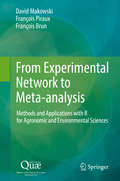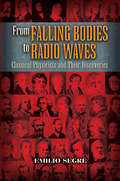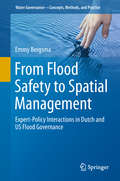- Table View
- List View
From Computational Logic to Computational Biology: Essays Dedicated to Alfredo Ferro to Celebrate His Scientific Career (Lecture Notes in Computer Science #14070)
by Domenico Cantone Alfredo PulvirentiAlfredo Ferro’s impact on information technology has traversed diverse domains, encompassing Computational Logic, Data Mining, Bioinformatics, and Complex Systems. After first studying Mathematics at the University of Catania, he received a Ph.D. in Computer Science from NYU in 1981, working under the supervision of Jacob Theodor (Jack) Schwartz. He returned to the University of Catania where he established the Computer Science undergraduate program, served as the coordinator of the Ph.D. program in Computer Science, cofounded the Ph.D. program in Biology, Human Genetics, and Bioinformatics, and retired as a full professor in 2021.Alfredo’s academic career as a computer scientist is characterized by two distinct research phases: Computational Logic until approximately 1995, followed by a notable focus on Data Mining and Bioinformatics. The contributions in this volume reflect the quality and the scope of his personal and collaborative successes.He also taught andinspired many excellent scientists. A pioneering initiative was to establish summer schools for Ph.D. students in 1989, leading to the so-called Lipari School, now the J.T. Schwartz International School for Scientific Research, where Alfredo continues to serve as director. This prestigious series includes schools focused on Computer Science, Complex Systems, and Computational Biology, featuring world-class scientists as lecturers and mentors.
From Creep Damage Mechanics to Homogenization Methods
by Holm Altenbach Tetsuya Matsuda Dai OkumuraThis volume presents a collection of contributions on materials modeling, which were written to celebrate the 65th birthday of Prof. Nobutada Ohno. The book follows Prof. Ohno's scientific topics, starting with creep damage problems and ending with homogenization methods.
From Curiosity to Deep Learning: Personal Digital Inquiry in Grades K-5
by Julie Coiro Elizabeth Dobler Karen PelekisFrom Curiosity to Deep Learning: Personal Digital Inquiry in Grades K-5 reveals the powerful learning that results when you integrate purposeful technology into a classroom culture that values curiosity and deep learning. The centerpiece of this practical guide is Personal Digital Inquiry (PDI), a framework developed by Julie Coiro and implemented in classrooms by her co-authors, Elizabeth Dobler and Karen Pelekis. Clear, detailed examples offer ideas for K-5 teachers and school librarians to support their teaching.Personal emphasizes the significance of the personal relationship between teachers and students, and the role that students have in the learning process. Digital reflects the important role that digital texts and tools have come to play in both learning and teaching with inquiry. Inquiry lies at the core of PDI, because learners grow and change with opportunities to identify problems, generate personal wonderings, and engage in collaborative dialogue, making learning relevant and lasting.From Curiosity to Deep Learning: Personal Digital Inquiry in Grades K-5 shows you how to integrate inquiry with a range of digital tools and resources that will create a dynamic classroom for both you and your students.
From Current Algebra to Quantum Chromodynamics
by Tian Yu Cao"The advent of quantum chromodynamics (QCD) in the early 1970s was one of the most important events in twentieth-century science. This book examines the conceptual steps that were crucial to the rise of QCD, placing them in historical context against the background of debates that were ongoing between the bootstrap approach and composite modeling, and between mathematical and realistic conceptions of quarks. It explains the origins of QCD in current algebra and its development through high-energy experiments, model-building, mathematical analysis and conceptual synthesis. Addressing a range of complex physical, philosophical and historiographical issues in detail, this book will interest graduate students and researchers in physics and in the history and philosophy of science"--
From DNA to Diversity: Molecular Genetics and the Evolution of Animal Design
by Sean B. Carroll Scott D. Weatherbee Jennifer K. GrenierIn this landmark work, the author team led by Dr. Sean Carroll presents the general principles of the genetic basis of morphological change through a synthesis of evolutionary biology with genetics and embryology. In this extensively revised second edition, the authors delve into the latest discoveries, incorporating new coverage of comparative genomics, molecular evolution of regulatory proteins and elements, and microevolution of animal development. An accessible text, focusing on the most well-known genes, developmental processes and taxa. Builds logically from developmental genetics and regulatory mechanisms to evolution at different genetic morphological levels. Adds major insights from recent genome studies, new evo-devo biology research findings, and a new chapter on models of variation and divergence among closely related species. Provides in-depth focus on key concepts through well-developed case studies. Features clear, 4-color illustrations and photographs, chapter summaries, references and a glossary. Presents the research of Dr. Carroll, a pioneer in the field and the past president of the Society for Developmental Biology.
From Darwin to Derrida: Selfish Genes, Social Selves, and the Meanings of Life (The\mit Press Ser.)
by David HaigHow the meaningless process of natural selection produces purposeful beings who find meaning in the world.In From Darwin to Derrida, evolutionary biologist David Haig explains how a physical world of matter in motion gave rise to a living world of purpose and meaning. Natural selection, a process without purpose, gives rise to purposeful beings who find meaning in the world. The key to this, Haig proposes, is the origin of mutable “texts”—genes—that preserve a record of what has worked in the world. These texts become the specifications for the intricate mechanisms of living beings.Haig draws on a wide range of sources—from Laurence Sterne's Tristram Shandy to Immanuel Kant's Critique of the Power of Judgment to the work of Jacques Derrida to the latest findings on gene transmission, duplication, and expression—to make his argument. Genes and their effects, he explains, are like eggs and chickens. Eggs exist for the sake of becoming chickens and chickens for the sake of laying eggs. A gene's effects have a causal role in determining which genes are copied. A gene (considered as a lineage of material copies) persists if its lineage has been consistently associated with survival and reproduction. Organisms can be understood as interpreters that link information from the environment to meaningful action in the environment. Meaning, Haig argues, is the output of a process of interpretation; there is a continuum from the very simplest forms of interpretation, instantiated in single RNA molecules near the origins of life, to the most sophisticated. Life is interpretation—the use of information in choice.
From Data to Quanta: Niels Bohr’s Vision of Physics
by Slobodan PerovicThe first comprehensive philosophical and historical account of the experimental foundations of Niels Bohr’s practice of physics. Niels Bohr was a central figure in quantum physics, well known for his work on atomic structure and his contributions to the Copenhagen interpretation of quantum mechanics. In this book, philosopher of science Slobodan Perovic explores the way Bohr practiced and understood physics, and analyzes its implications for our understanding of modern science. Perovic develops a novel approach to Bohr’s understanding of physics and his method of inquiry, presenting an exploratory symbiosis of historical and philosophical analysis that uncovers the key aspects of Bohr’s philosophical vision of physics within a given historical context. To better understand the methods that produced Bohr’s breakthrough results in quantum phenomena, Perovic clarifies the nature of Bohr’s engagement with the experimental side of physics and lays out the basic distinctions and concepts that characterize his approach. Rich and insightful, Perovic’s take on the early history of quantum mechanics and its methodological ramifications sheds vital new light on one of the key figures of modern physics.
From Deep Sea to Laboratory 1: The First Explorations of the Deep Sea by H.M.S. Challenger (1872-1876)
by Frederic Aitken Jean-Numa FoulcThe scientific expedition of H.M.S. Challenger in the 1870s marks the starting point of physical oceanography. This ship traveled the seas of the globe pursuing a dual objective: to conduct an in-depth study of animal life and to observe the physical properties of ocean waters. Volume 1, richly illustrated, relates the expedition of the Challenger and addresses the problems of measuring the great depths. A theoretical approach to the immersion velocity of a probe is also proposed, as well as a presentation of some results of bathymetric surveys and physical observations made by the Challenger scientists. From Deep Sea to Laboratory is available in three volumes for curious readers drawn to travel, history and science. Students, researchers and teachers of physics, fluid mechanics and oceanography will find material to deepen their knowledge.
From Dissent to Diplomacy: The Pugwash Project During the 1960s Cold War (SpringerBriefs in History of Science and Technology)
by Alison KraftThis book provides new and critical perspectives on the internal development of the Pugwash Conferences on Science and World Affairs (the PCSWA; Pugwash) and its role in international nuclear diplomacy during the 1960s Cold War. Conceived by western scientists dissenting from their own government’s position on nuclear weapons, the conferences brought together elite scientists from across the East-West divide to work towards nuclear disarmament and for peace. The analysis follows two lines. First, the book charts the emergence during the conferences of a distinctive form of technopolitical communication that was crucial to the role of Pugwash in Informal cross-bloc dialogue about disarmament. This enabled Pugwash to realize its paradoxical vision of working both with and against governments to promote disarmament and was key to its role as both a forum for and actor within the realm of informal diplomacy. It is argued that Pugwash scientists formed the vanguard of what came in the 1960s to be called Track II diplomacy. The relevance of the contemporary concept of Science Diplomacy for Pugwash is discussed. The second analytical focus of the book centers on the internal dynamics of the international Pugwash organization. It is argued that informal modes of working and a code of confidentiality accorded the leadership enormous power and autonomy: this small network of senior figures was able to control the Pugwash agenda and priorities, and to launch diplomatic initiatives beyond the conferences. However, by 1967, competing interests were fueling tensions and instability within Pugwash as it struggled for coherence and direction amid with the political challenges posed by the Vietnam War and European security. This crisis manifest the limits of the Pugwash project and placed its future in doubt.
From Dust to Life
by Jacqueline Mitton John ChambersThe birth and evolution of our solar system is a tantalizing mystery that may one day provide answers to the question of human origins. This book tells the remarkable story of how the celestial objects that make up the solar system arose from common beginnings billions of years ago, and how scientists and philosophers have sought to unravel this mystery down through the centuries, piecing together the clues that enabled them to deduce the solar system's layout, its age, and the most likely way it formed. Drawing on the history of astronomy and the latest findings in astrophysics and the planetary sciences, John Chambers and Jacqueline Mitton offer the most up-to-date and authoritative treatment of the subject available. They examine how the evolving universe set the stage for the appearance of our Sun, and how the nebulous cloud of gas and dust that accompanied the young Sun eventually became the planets, comets, moons, and asteroids that exist today. They explore how each of the planets acquired its unique characteristics, why some are rocky and others gaseous, and why one planet in particular--our Earth--provided an almost perfect haven for the emergence of life. From Dust to Life is a must-read for anyone who desires to know more about how the solar system came to be. This enticing book takes readers to the very frontiers of modern research, engaging with the latest controversies and debates. It reveals how ongoing discoveries of far-distant extrasolar planets and planetary systems are transforming our understanding of our own solar system's astonishing history and its possible fate.
From Dust to Life: The Origin and Evolution of Our Solar System
by Jacqueline Mitton John ChambersThe birth and evolution of our solar system is a tantalizing mystery that may one day provide answers to the question of human origins. From Dust to Life tells the remarkable story of how the celestial objects that make up the solar system arose from common beginnings billions of years ago, and how scientists and philosophers have sought to unravel this mystery down through the centuries, piecing together the clues that enabled them to deduce the solar system's layout, its age, and the most likely way it formed. Drawing on the history of astronomy and the latest findings in astrophysics and the planetary sciences, John Chambers and Jacqueline Mitton offer the most up-to-date and authoritative treatment of the subject available. They examine how the evolving universe set the stage for the appearance of our Sun, and how the nebulous cloud of gas and dust that accompanied the young Sun eventually became the planets, comets, moons, and asteroids that exist today. They explore how each of the planets acquired its unique characteristics, why some are rocky and others gaseous, and why one planet in particular--our Earth--provided an almost perfect haven for the emergence of life. From Dust to Life is a must-read for anyone who desires to know more about how the solar system came to be. This enticing book takes readers to the very frontiers of modern research, engaging with the latest controversies and debates. It reveals how ongoing discoveries of far-distant extrasolar planets and planetary systems are transforming our understanding of our own solar system's astonishing history and its possible fate.
From ER to E.T.: How Electromagnetic Technologies Are Changing Our Lives
by Rajeev BansalThis book sweeps the broad field of applied electromagnetics and describes how electromagnetic technologies affect our daily lives. Presents topics that investigate many aspects of electromagnetic technology throughout history Explores societal and global issues that relate to the field of electrical engineering (emphasized in current ABET accreditation criteria) Includes light-hearted quizzes (with answers) relevant to every chapter, which add additional zest to the technical material
From Egg to Chicken (Lifecycles Series)
by Gerald LeggLarge illustrations and simple text describe what an egg is made of and how it hatches into a chicken.
From Electrons to Elephants and Elections: Exploring the Role of Content and Context (The Frontiers Collection)
by Ian Stewart Shyam WuppuluriThis highly interdisciplinary book, covering more than six fields, from philosophy and sciences all the way up to the humanities and with contributions from eminent authors, addresses the interplay between content and context, reductionism and holism and their meeting point: the notion of emergence. Much of today’s science is reductionist (bottom-up); in other words, behaviour on one level is explained by reducing it to components on a lower level. Chemistry is reduced to atoms, ecosystems are explained in terms of DNA and proteins, etc. This approach fails quickly since we can’t cannot extrapolate to the properties of atoms solely from Schrödinger's equation, nor figure out protein folding from an amino acid sequence or obtain the phenotype of an organism from its genotype. An alternative approach to this is holism (top-down). Consider an ecosystem or an organism as a whole: seek patterns on the same scale. Model a galaxy not as 400 billion-point masses (stars) but as an object in its own right with its own properties (spiral, elliptic). Or a hurricane as a structured form of moist air and water vapour. Reductionism is largely about content, whereas holistic models are more attuned to context. Reductionism (content) and holism (context) are not opposing philosophies — in fact, they work best in tandem. Join us on a journey to understand the multifaceted dialectic concerning this duo and how they shape the foundations of sciences and humanities, our thoughts and, the very nature of reality itself.
From Environmental to Comprehensive Security
by Arthur H. WestingThis work presents the evolution of the traditional concept of "national security" as military security to additionally embrace "environmental security" and then necessarily also "social (societal) security", thence to be termed "comprehensive human security". It accomplishes this primarily by presenting 11 of the author's own benchmark papers published between 1983 and 2010 (additionally providing bibliographic citations to a further 36 of the author's related publications during that period). The work stresses the importance of transfrontier (regional) cooperation, and also recognizes global overpopulation as a key impediment to achieving comprehensive human security.
From Eros to Gaia
by Freeman DysonReaders of Freeman Dyson's previous books, Disturbing the Universe, Weapons and Hope, and Infinite in All Directions, have discovered for themselves what Dyson reveals here: that he was a writer long before he became a distinguished scientist. The aim of this new book, as Dyson says, is to open windows, to let the experts inside the temple of science see out, and to let the ordinary citizens outside see in." In this process an immensely broad range of ideas, people, contemporary history, and discoveries of many sorts pass in review. Beginning with a piece of writing he did as a child and ending with recent work, he goes from Eros, the god or youthful passion, to Gaia, the fertile life-giving mother-planet Earth. The pilgrimage is a good metaphor for the life of a writer. This book is full of discoveries. In the company of one of the most lucid minds of our time, one approaches great men and problems central to our common existence. Always there is warmth, kindness, high intelligence and humor. Dyson is intimate with both science and man. Whether he is dealing with the problems of physics or politics, whether he is engrossed in astronomy or literature, whether he is concentrating on an African village of space science, Dyson's view is always "infinite in all directions," always following the path of diversity, always keeping his eye on the wonder of our earth and the health and happiness of its inhabitants.
From Eternity to Here
by Sean CarrollA rising star in theoretical physics offers his awesome vision of our universe and beyond, all beginning with a simple question: Why does time move forward?Time moves forward, not backward--everyone knows you can't unscramble an egg. In the hands of one of today's hottest young physicists, that simple fact of breakfast becomes a doorway to understanding the Big Bang, the universe, and other universes, too. In From Eternity to Here, Sean Carroll argues that the arrow of time, pointing resolutely from the past to the future, owes its existence to conditions before the Big Bang itself--a period modern cosmology of which Einstein never dreamed. Increasingly, though, physicists are going out into realms that make the theory of relativity seem like child's play. Carroll's scenario is not only elegant, it's laid out in the same easy-to- understand language that has made his group blog, Cosmic Variance, the most popular physics blog on the Net. From Eternity to Here uses ideas at the cutting edge of theoretical physics to explore how properties of spacetime before the Big Bang can explain the flow of time we experience in our everyday lives. Carroll suggests that we live in a baby universe, part of a large family of universes in which many of our siblings experience an arrow of time running in the opposite direction. It's an ambitious, fascinating picture of the universe on an ultra-large scale, one that will captivate fans of popular physics blockbusters like Elegant Universe and A Brief History of Time.Watch a Video
From Eternity to Here: The Quest for the Ultimate Theory of Time
by Sean CarrollTwenty years ago, Stephen Hawking tried to explain time by understanding the Big Bang. Now, Sean Carroll says we need to be more ambitious. One of the leading theoretical physicists of his generation, Carroll delivers a dazzling and paradigm-shifting theory of time's arrow that embraces subjects from entropy to quantum mechanics to time travel to information theory and the meaning of life. From Eternity to Here is no less than the next step toward understanding how we came to exist, and a fantastically approachable read that will appeal to a broad audience of armchair physicists, and anyone who ponders the nature of our world.
From Eternity to Here: The Quest for the Ultimate Theory of Time
by Sean CarrollA rising star in theoretical physics offers his awesome vision of our universe and beyond, all beginning with a simple question: Why does time move forward?Time moves forward, not backward--everyone knows you can't unscramble an egg. In the hands of one of today's hottest young physicists, that simple fact of breakfast becomes a doorway to understanding the Big Bang, the universe, and other universes, too. In From Eternity to Here, Sean Carroll argues that the arrow of time, pointing resolutely from the past to the future, owes its existence to conditions before the Big Bang itself--a period modern cosmology of which Einstein never dreamed. Increasingly, though, physicists are going out into realms that make the theory of relativity seem like child's play. Carroll's scenario is not only elegant, it's laid out in the same easy-to- understand language that has made his group blog, Cosmic Variance, the most popular physics blog on the Net. From Eternity to Here uses ideas at the cutting edge of theoretical physics to explore how properties of spacetime before the Big Bang can explain the flow of time we experience in our everyday lives. Carroll suggests that we live in a baby universe, part of a large family of universes in which many of our siblings experience an arrow of time running in the opposite direction. It's an ambitious, fascinating picture of the universe on an ultra-large scale, one that will captivate fans of popular physics blockbusters like Elegant Universe and A Brief History of Time.Watch a Video
From Eternity to Here: The Quest for the Ultimate Theory of Time
by Sean CarrollTwenty years after Stephen Hawking's 9-million-copy selling A Brief History of Time, pioneering theoretical physicist Sean Carroll takes our investigation into the nature of time to the next level. You can't unscramble an egg and you can't remember the future. But what if time doesn't (or didn't!) always go in the same direction? Carroll's paradigm-shifting research suggests that other universes experience time running in the opposite direction to our own. Exploring subjects from entropy and quantum mechanics to time travel and the meaning of life, Carroll presents a dazzling new view of how we came to exist.
From Evolutionary Biology to Economics and Back: Parallels and Crossings between Economics and Evolution (History, Philosophy and Theory of the Life Sciences #28)
by Philippe Huneman Jean Gayon Bernard Walliser Mikael Cozic Jean-Baptiste André Silvia De Monte Johannes MartensThis book offers a comprehensive exploration of the major key concepts common to economics and evolutionary biology. Written by a group of philosophers of science, biologists and economists, it proposes analyses of the meaning of twenty-five concepts from the viewpoint respectively of economics and of evolutionary biology –each followed by a short synthesis emphasizing major discrepancies and commonalities. This analysis is surrounded by chapters exploring the nature of the analogy that connects evolution and economics, and chapters that summarize the major teachings of the analyses of the keywords. Most scholars in biology and in economics know that their science has something in common with the other one, for instance the notions of competition and resources. Textbooks regularly acknowledge that the two fields share some history – Darwin borrowing from Malthus the insistence on scarcity of resources, and then behavioral ecologists adapting and transforming game theory into evolutionary game theory in the 1980s, while Friedman famously alluded to a Darwinian process yielding the extant firms. However, the real extent of the similarities, the reasons why they are so close, and the limits and even the nature of the analogy connecting economics and biological evolution, remain inexplicit. This book proposes basis analyses that can sustain such explication. It is intended for researchers, grad students and master students in evolutionary and in economics, as well as in philosophy of science.
From Experimental Kinetic Data to Reaction Mechanisms (Physical Chemistry in Action)
by Carlos Bravo-Diaz Sonia Losada-Barreiro José G. Santos Margarita E. AliagaThis textbook offers a deep dive into practical kinetics in solution, providing a comprehensive overview of the techniques and methods used to monitor chemical reactions. It addresses fundamental questions about reaction rates, rate laws, and the intricate dynamics of chemical processes. By connecting various experimental aspects required for kinetic and mechanistic research, it guides students on how to obtain, treat, and interpret experimental data to gain realistic mechanistic insights. Divided into nine chapters, the textbook begins with an introduction to the basic concepts of chemical kinetics and an experimental perspective on monitoring chemical reactions. Subsequent chapters cover complex reactions, offering insights into simplifying reaction schemes through steady-state and pre-equilibrium approximations. Special attention is given to reactions in solution, highlighting diffusion-controlled and activation-controlled reactions, as well as the role of catalysis. The authors provide expert analyses of chemical reactivity in multiphasic systems, such as microemulsions and emulsions, offering a detailed understanding of these complex environments. The textbook also focuses on the analysis of kinetic data, including the effects of solution composition. It explores non-linear regression analyses, residuals, dataset size, noise, fitting functions, and the limits of fitting algorithms. Additionally, it presents comparisons between fitting data and experimental data, providing readers with valuable insights. This textbook is an invaluable resource for upper-undergraduate and graduate students conducting research in reaction kinetics. It is also essential for researchers and practitioners in chemistry, particularly those interested in reaction kinetics and chemical reactivity. With contributions from leading experts, this volume is a must-read for anyone looking to advance their understanding of chemical kinetics.
From Experimental Network to Meta-analysis: Methods and Applications with R for Agronomic and Environmental Sciences
by David Makowski François Piraux François BrunThis book has been designed as a methodological guide and shows the interests and limitations of different statistical methods to analyze data from experimental networks and to perform meta-analyses. It is intended for engineers, students and researchers involved in data analysis in agronomy and environmental science.
From Falling Bodies to Radio Waves: Classical Physicists and Their Discoveries
by Emilio SegrèMeet a diverse group of highly original thinkers and learn about their lives and achievements: Galileo, a founding father of astronomy and physics; Christiaan Huygens, a seventeenth-century pioneer of wave-particle duality; and Isaac Newton, the English mathematician and physicist who laid the groundwork for a scientific revolution and promoted radical investigation as the means to reveal nature's hidden workings.This chronicle of physics and physicists traces the development of scientific thought from these originators to their successors, among them Faraday, Watts, Helmholtz, Maxwell, Boltzmann, and Gibbs. Combining his own engaging style with the physicists' original writings, the author illustrates the evolution of individual physical ideas, as well as their roles in the wider field.A student and colleague of Enrico Fermi, Emilio Segrè (1905-89) made numerous important contributions to nuclear physics, including his participation in the Manhattan Project. A Nobel laureate, Segrè is further renowned for his narrative skills as an historian. Hailed by the Journal of the History of Astronomy as "charming and witty," this book is a companion to the author's From X-Rays to Quarks: Modern Physicists and Their Discoveries, also available from Dover Publications.
From Flood Safety to Spatial Management: Expert-Policy Interactions in Dutch and US Flood Governance (Water Governance - Concepts, Methods, and Practice)
by Emmy BergsmaThis book deals with the introduction of a new type of “spatial measures" in flood governance. In contrast to traditional “safety measures" that aim to provide protection against floods by building structural flood defenses such as levees and flood walls, the goal of spatial measures is to reduce the exposure to flood risks by changing the spatial layout of flood-prone areas. By limiting developments and flood-proofing buildings in areas at risk to flooding, investments in structural flood defenses can be circumvented and vulnerabilities reduce. World-wide, spatial measures are gaining attractiveness as a response strategy to increasing flood risks caused by climate change and urbanization. The introduction of spatial measures in flood governance involves more than the simple development of new policies and laws. Research has demonstrated that the implementation of spatial measures can have huge implications for how costs and responsibilities are divided between different levels of governance and between public and private actors, changing the whole organization behind flood governance. Both for the effectiveness and for the legitimacy of spatial flood governance strategies, it is important that these distributive implications are well understood. This book describes the introduction of spatial measures in the context of two very different delta countries: the Netherlands and the United States. In the United States, a spatial flood governance strategy was already developed in de mid-20th century whereas in the Netherlands, a safety paradigm institutionalized over the course of the 20th century and spatial measures have only recently been introduced. By analyzing the science-policy interactions underlying the implementation of spatial measures in both countries, this book shows how under the influence of different types of experts (engineers in the Netherlands and social geographers in the United States) different spatial flood management strategies emerged with different distributive implications, each with its own challenges for effectiveness and legitimacy.
